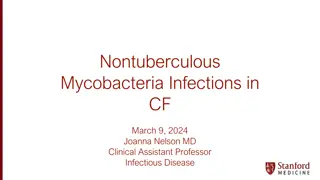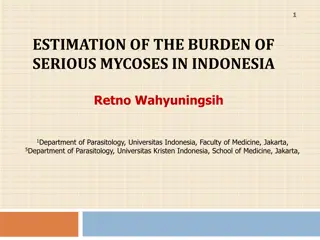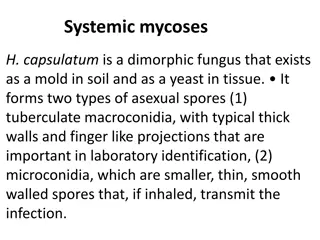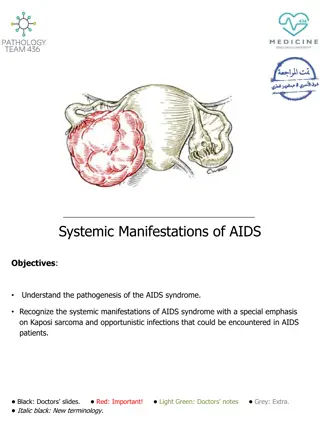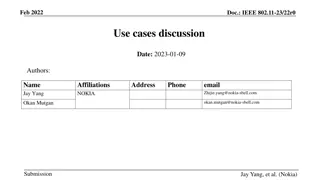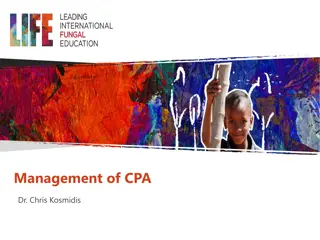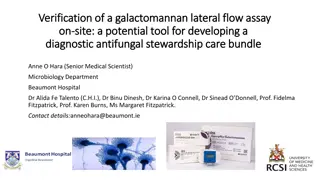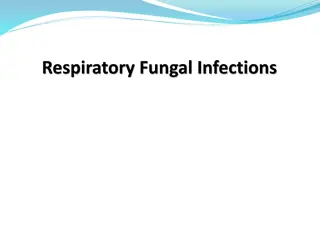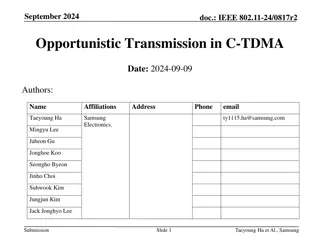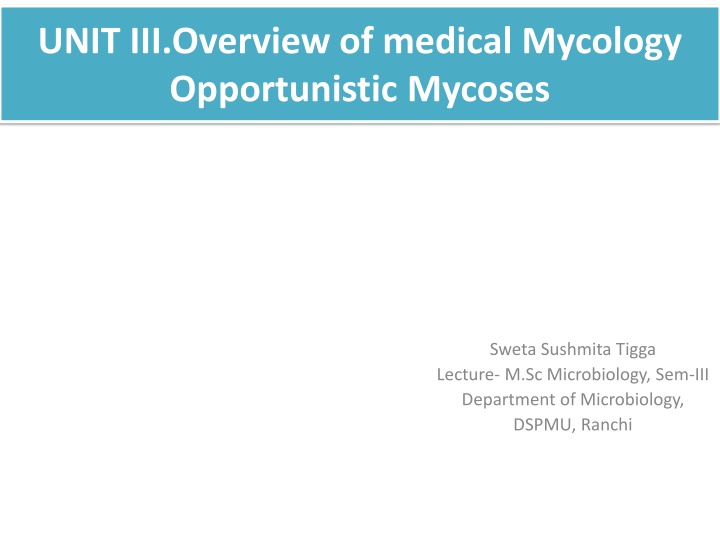
Overview of Opportunistic Mycoses and Aspergillosis
Opportunistic mycoses are infections caused by normally harmless organisms that become pathogenic in compromised hosts. Aspergillosis is a fungal infection primarily caused by Aspergillus species, commonly affecting the respiratory tract. Learn about the major opportunistic mycoses and Aspergillosis manifestations, diagnosis, and treatment options.
Download Presentation

Please find below an Image/Link to download the presentation.
The content on the website is provided AS IS for your information and personal use only. It may not be sold, licensed, or shared on other websites without obtaining consent from the author. If you encounter any issues during the download, it is possible that the publisher has removed the file from their server.
You are allowed to download the files provided on this website for personal or commercial use, subject to the condition that they are used lawfully. All files are the property of their respective owners.
The content on the website is provided AS IS for your information and personal use only. It may not be sold, licensed, or shared on other websites without obtaining consent from the author.
E N D
Presentation Transcript
UNIT III.Overview of medical Mycology Opportunistic Mycoses Sweta Sushmita Tigga Lecture- M.Sc Microbiology, Sem-III Department of Microbiology, DSPMU, Ranchi
Opportunistic Mycoses An Opportunistic organisms is generally harmless in its normal environment but becomes pathogenic in a compromised host. Compromised host is seriously debilitated and has lowered resistance to infection. There are many causes of this condition- 1. malnutrition 2. Cancer 3. Leukemia or another infectious disease 4. Trauma from surgery or injury
Opportunistic Mycoses The most important opportunistic mycoses include- Pneumocystis pneumonia or Pneumocystis carinii pneumonia (PCP) Systemic Aspergillosis Candidiasis
Aspergillosis Aspergillus is omnipresent in nature, being found wherever organic debris occurs. Aspergillus fumigatus is the usual cause of aspergillosis. A. flavus is the second most important species, particularly in immunosuppressed patients.
Aspergillosis The major portal of entry for Aspergillus is the respiratory tract. Inhalation of conidiospores can lead to several types of pulmonary aspergillosis. One type is allergic aspergillosis. Infected individuals may develop an immediate allergic response and suffer typical asthmatic attacks when exposed to fungal antigens on the conidiospores. In bronchopulmonary aspergillosis the major clinical manifestation of the allergic response is a bronchitis resulting from both type I and type III hypersensitivities
Aspergillosis Although tissue invasion seldom occurs in bronchopulmonary Aspergillus often can be cultured from the sputum. aspergillosis, A most common manifestation of pulmonary involvement occurrence of colonizing aspergillosis, in which Aspergillus forms colonies within the lungs that develop into fungus balls called aspergillomas. is the
Aspergillosis Laboratory examination of pathological specimens or by isolation and characterization of the fungus. Treatment- itraconazole. Diagnosis- Either by direct
Candidiasis Candidiasis is the mycosis caused by the dimorphic fungus Candida albicans. Oral candidiasis or thrush, is a common disease in newborns. It is seen as many small white flecks that cover the tongue and mouth. At birth, newborns do not have a normal microbiota in the oralpharyngeal area. If mother s vaginal area is heavily infected with C. albicans, theupper respiratory tract of the newborn becomes colonized during passage through birth canal. Thrush occurs because growth of C. albicans cannot be inhibited by the other microbiota. Once the newborn baby has developed its own normal oropharyngeal microbiota, thrush becomes uncommon.
Candidiasis Paronychia and Onychomycosis are associated with Candida infections of the subcutaneous tissues of the digits and nails, respectively Diagnosis- I. This fungus is a frequent secondary invader in diseased hosts II. A mixed microbiota often found in the diseased tissue Treatment i. Cutaneous lesions can be treated with topical agents such as sodium caprylate, sodium propionate, gentian violet, nystatin, miconazole and trichomycin. ii. Ketoconazole, amphotericin B, fluconazole, itraconazole and flucytosine also can be used for systemic candidiasis.
Pneumocystis pneumonia or Pneumocystis carinii pneumonia (PCP)
Pneumocystis pneumonia or Pneumocystis carinii pneumonia (PCP) Pneumocystis jiroveci is a fungus found in the lungs of a wide variety of mammals. The disease that this fungus causes has been called Pneumocystis pneumonia or Pneumocystis carinii pneumonia (PCP). Its name was changed to Pneumocystis jiroveci in honor of the Czech parasitologist, Otto Jirovec, who first described this pathogen in humans. PCP now stands for Pneumocystis pneumonia.
Pneumocystis pneumonia or Pneumocystis carinii pneumonia (PCP) Serological data indicate that most humans are exposed to P. jiroveci by age three or four. However, PCP occurs immunocompromised hosts. immunosuppressive drugs and irradiation for the treatment of cancers and following organ transplants accounts for the formidable prevalence rates for PCP. This pneumonia also occurs in premature, malnourished infants and in more than 80% of HIV positive patients who have progressed to AIDS almost exclusively Extensive in of use
Pneumocystis pneumonia or Pneumocystis carinii pneumonia (PCP) Both the organism and the disease remain localized in the lungs-even in fatal cases. Within the lungs, P. jiroveci causes the alveoli to fill with a frothy exudate. Laboratory diagnosis pneumonia can be made definitively only by microscopically demonstrating the presence of the microorganisms in infected lung material or by a PCR analysis. - Pneumocystis
Pneumocystis pneumonia or Pneumocystis carinii pneumonia (PCP) Treatment is by means of oxygen therapy and either a combination of trimethoprim and sulfamethoxazole, trimetrexate. Prevention and control - with drugs, such as fluconazole, in susceptible persons. atovaquone or

